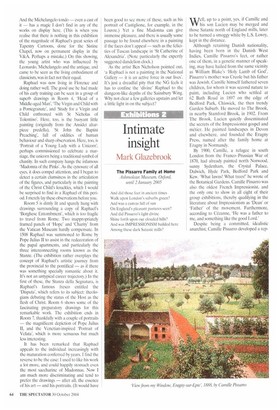Intimate insight
Mark Glazebrook
The Pissarro Family at Home Ashmolean Museum, Oxford,
until 2 January 2005
And did those feet in ancient times Walk upon London's suburbs green? And was a canvas full of sun On England's pleasant pastures seen? And did Pissarro's light divine Shine forth upon our clouded hills? And was IMPRESSIONISM builded here Among these dark Satanic mills?
Well, up to a point, yes, if Camille and his son Lucien may be merged and those Satanic north of England mills, later to be turned a smoggy white by L.S. Lowry, kept in the distance.
Although retaining Danish nationality, having been born in the Danish West Indies, Camille Pissarro's feet, or rather one of them, in a genetic manner of speaking, may have hailed from the same vicinity as William Blake's 'Holy Lamb of God'. Pissarro's mother was Creole but his father was Jewish. Camille himself fathered seven children, for whom it was second nature to paint, including Lucien who settled at 62 Bath Road in 1897 on the edge of Bedford Park, Chiswick, the then trendy Garden Suburb. He moved to The Brook, in nearby Stamford Brook, in 1902. From The Brook, Lucien quietly disseminated the secrets of the Impressionist gospel and métier. He painted landscapes in Devon and elsewhere, and founded the Eragny Press, named after the family home at Eragny in Normandy.
By 1900, Camille, a refugee in south London from the Franco–Prussian War of 1870, had already painted north Norwood, sunny Sydenham, the Crystal Palace, Dulwich, Hyde Park, Bedford Park and Kew. 'What lawns! What trees!' he wrote of the Botanical Gardens. Camille Pissarro was also the oldest French Impressionist, and the only one to show in all eight of their group exhibitions, thereby qualifying in the literature about Impressionism as `Dean' or 'Father' of the movement. Furthermore, according to Cezanne, 'He was a father to me, and something like the good Lord.'
Despite being a committed, idealistic anarchist, Camille Pissarro developed a rep utation as a sage. A late self-portrait borrowed from the Tate for this exhibition cements such an image. With his great black beard, later turning white, Pissarro looked thoroughly patriarchal, rabbinical even, but he did not practise the Jewish faith. Nor did he use his art to further his anarchical political views. The faith Pissarro practised and passed on to his eldest son Lucien was the Impressionist faith. He had studied the old masters in the Louvre. Together with Monet, he studied the best English landscape painters. Rembrandt was an etching mentor. Corot was an early, major and permanent influence, yet he kept up with the younger generation, experimenting seriously with Divisionism, or Neo-Impressionism, for example — as did Lucien.
The point of this exhibition is to focus on the domestic background from which this unique family of artists lived, worked so incessantly, and died. There is much sadness when the attractive child known as Minette dies young. The show includes works by, and of, all Lucien Pissarro's siblings, such as Felix (Titi'), George, Ludovic-Roclo, and Jeanne ('Cocotte'). Lucien's amazing-looking daughter Orovida is present, too, notably in a portrait by Card l Weight, commissioned by her and painted in her home in 1956. Almost all the exhibits are from the extensive Pissarro Family Gift to the Ashmolean of 1952, which was supplemented in 2003 by more than 600 items.
Do not expect a blockbuster show of great Impressionist works. The Pissarros, in any case, tended to embrace everyday reality and to avoid grand subject-matter. The labels are to the point but there is no catalogue. Expect instead a context of social history and an intimate insight into a family that was at the heart of an important movement. The first room shows the Pissarros in various houses in France. The second nxml shows them in England. At The Brook, on alternate Sundays, Lucien's wife Esther (née Bensusan) would hold soirees — modest food and drink followed by a friend playing Bach on the piano. These might be attended by the head of the British Museum Print Room, by Aitken and Manson, successive directors of the Tate, and by painters of the Camden Town School. Sickert said of Lucien: 'Pissarro, holding the exceptional position at once of an original talent, and the pupil of his father, the authoritative depository of a mass of inherited knowledge and experience, has certainly acted as a guide, or, let us say, a dictionary of theory and practice on the road we have elected to travel.'
Renoir painted in the Channel Islands. Berthe Morisot depicted Manet's brother through a guesthouse window on the Isle of Wight. Van Gogh worked for a London gallery, preached in Chiswick and helped make Brixton famous. Monet and Derain immortalised the Thames near Westminster. We are lucky that part of the Pissarro family actually settled in suburban London and entrusted a massive archive of both family and Impressionist history to the Ashmolean.



















































































































 Previous page
Previous page